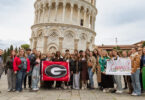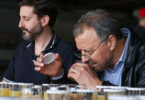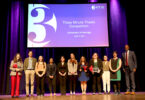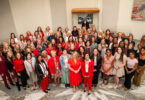Athens, Ga. – University of Georgia art professor R.G. Brown confounds traditional concepts of art by creating sculptures-only to bury them underground. Using ground-penetrating radar and electromagnetic conductivity to survey the buried forms, Brown then challenges the viewer to rediscover them indirectly, as reflected digital images.
This marriage of art and science embraces technology in conjuring a range of images in various colors and forms. Some of the images resemble raised-relief maps of mountain ranges. Others, printed as overhead “slices,” look more like a local radar image of a thunderstorm, with red and yellow storm cells embedded inside larger areas of light rain.
“The idea is that the piece really exists in a parallel way, not as we see it first-hand but as the instruments interpret it,” says Brown. “We can’t see air, gravity or microwaves, but we know they exist-and the powerful influences they exert on our lives.”
Brown’s current exhibit, A Notion of Journey, is on display through Nov. 6 at Augusta State University. In this project, part of the Augusta Westobou festival, Brown embedded (he doesn’t like to use the term “buried”) a 30-foot canoe shape on the campus of Augusta State. The canoe form was inspired by the term Westobou, the Native American name for the Savannah River. Images in the exhibition were derived from geo-archaeological surveys.
Brown, who is also trained as a landscape architect, took courses in remote sensing in graduate school. The idea for his current projects came to him while researching archaeological geophysics. He discovered on a web site that Ervan Garrison, a geologist who heads UGA’s department of anthropology, was using ground-penetrating radar in his own research to find and survey historic sites and locate buried objects in a non-invasive way.
“I was surprised to find that the expertise I needed was right here at UGA,” says Brown. “I contacted Garrison immediately about my idea. He didn’t think I was crazy-or at least he didn’t let on if he did. And his advice and expertise have been invaluable.”
Brown’s first effort, presented in a January 2007 exhibit called disPLACEMENTS: Georgia Arc, was installed in a field near campus. Garrison, along with Kent Schneider, an archeologist with the USDA Forest Service and geology graduate student Jessica Cook, surveyed the 32-foot embedded arc, which looks like a crescent moon made from luaun plywood, aluminum flashing and crushed granite.
The scientists marked off the area over the embedded arc in a grid pattern with lines about 18-inches apart. Walking over the grid with the ground-penetrating radar, they plotted the sculpture’s reflected image. Ground-penetrating radar uses electromagnetic radiation in the microwave band to detect reflected signals from subsurface structures.
The images’ strength and clarity depend on the reflectivity of the sculpture material, the soil type and its degree of compaction-and also the presence or absence of nearby objects, like buried rocks or metal posts. Brown chooses the color palette for the finished printed images, but makes clear that “I manipulate the color, but not the data; it’s real.”
With funding from the East Coast Sculpture Exchange, Brown has completed other such exhibits, including the Jamestown Triangle, based on a diagram of the original footprint of the colony’s fort and installed as a public art project at George Mason University in Fairfax, Va.; and Parallel, an installation on the beach at Key West, Fla. composed of two parallel rectangular monolithic columns.
Once surveyed, Brown removes his sculptures from the ground. The one exception is the Georgia Arc, which he left in place, and which now serves as a lab and practice site for UGA students learning to survey archeological sites.
“This is a true collaboration in the sense that this same technique [ground-penetrating radar] can be used in reverse to help archeologists interpret what they’re finding in unknown sites,” says Brown. “Their students can learn how to use the instruments on a known form.”
Now that he’s familiar with GPR imaging techniques, Brown wants to take his project a step further to explore the digital images in 3D form. Working with Thomas Jordan, at UGA’s Center for Mapping Science, Brown hopes to see his sculptures “through this evolution of sculpture, embedded image, and finally, a 3D dimensional model.”







